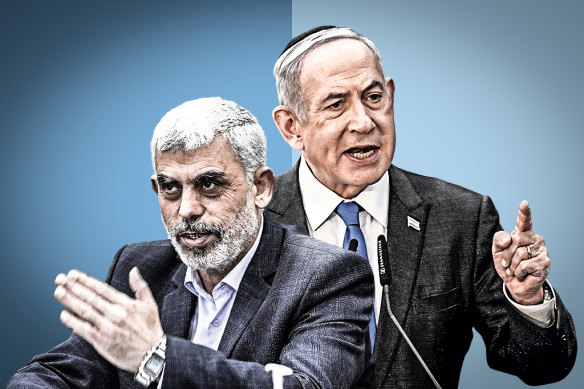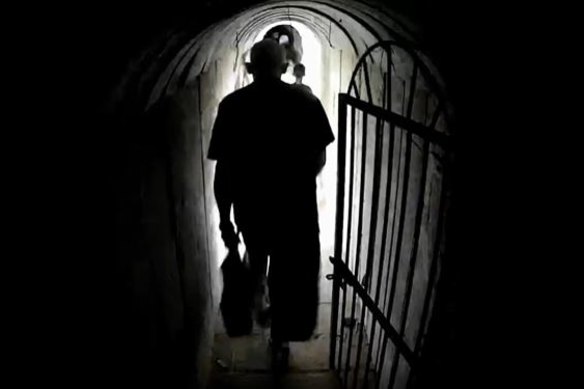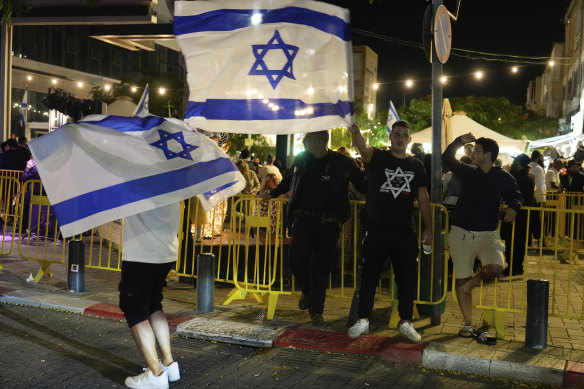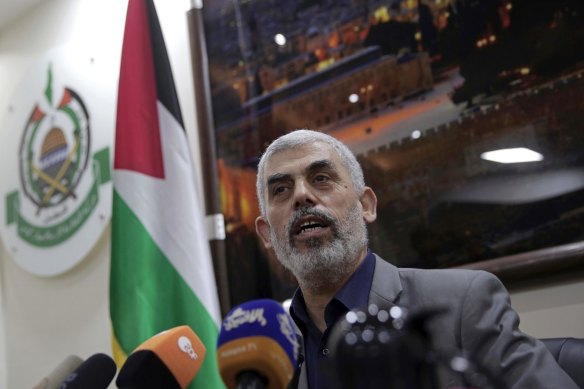This was published 8 months ago
Who was Yahya Sinwar, leader of Hamas?
By Ben Hubbard
Yahya Sinwar, the Palestinian militant leader who emerged from two decades of prison in Israel to rise to the helm of Hamas and help plot the deadliest assault on Israel in its history, has died. He was in his early 60s.
A longtime Hamas leader who assumed its top political office in August, Sinwar was known among supporters and enemies alike for combining cunning and brutality. He built Hamas’ ability to harm Israel in service of the group’s long-term goal of destroying the Jewish state and building an Islamist, Palestinian nation in its place.

Hamas leader Hamas Yahya Sinwar was killed by Israel and Israel PM Benjamin Netanyahu, who declared the score settled.Credit: Marija Ercegovac
He played a central role in planning the surprise assault on southern Israel on October 7, 2023, that killed about 1200 people, brought 250 others back to the Gaza Strip as hostages and put him at the top of Israel’s kill list. Israeli leaders vowed to hunt him down, and the military dropped flyers over Gaza offering a $US400,000 (nearly $600,000) reward for information on his whereabouts.
But for more than a year, he remained elusive, surviving in tunnels Hamas had dug beneath Gaza, even as Israel killed many of his fighters and associates.
Sinwar’s legacy among Palestinians is complex. He built a force capable of striking the Middle East’s most sophisticated military despite the tight Israeli-Egyptian blockade of Gaza. But the October 7 attack led Israel to commit not just to ending Hamas’ 17-year rule of Gaza, but also to destroying the group altogether.
The assault raised Hamas’ standing in the Israeli-occupied West Bank and elsewhere in the Arab world, according to polls, but not among Palestinians in Gaza, whose lives and homes bore the brunt of Israel’s subsequent invasion.

A screenshot from the video released by the IDF claiming to show Yahya Sinwar, the Hamas leader, in tunnels under Gaza on October 10, 2023.Credit: Screenshot/IDF
And while he succeeded at bringing the Palestinian cause back to the world’s attention, he failed to bring his people closer to independence or statehood – and at a tremendous cost to those whom he claimed to want to liberate. Israel reduced much of Gaza to rubble in response to Hamas’ attack, and more than 42,000 Palestinians were killed, according to Gaza health authorities.
When word of his death spread in Gaza, many people celebrated.
Mohammed, a 22-year-old who had been repeatedly displaced during the war, said he blamed Sinwar for the hunger, unemployment and homelessness the conflict had caused.
“He humiliated us, started the war, scattered us and made us displaced, without water, food or money,” Mohammed said, speaking on condition of anonymity for fear of reprisals from Hamas members. “He is the one who made Israel do this.”
The news of Sinwar’s death, he said, marked “the best day of my life”.

People wave the Israeli flag as they celebrate the news of the death of Hamas leader Yahya Sinwar, in Netanya, Israel.Credit: AP
As the leader of Hamas in Gaza starting in 2017, Sinwar quietly rekindled the group’s relationship with Iran, a long-time patron, helping Hamas develop the ability to outsmart Israel’s defences. And while covertly preparing for a giant war with Israel, he led Israel to believe that he wanted the opposite: not exactly peace, but at least some quiet.
Many in the Israeli security establishment spent the years before the war focusing on other threats and assuming that Gaza was under control, some said in interviews after the war began.
Sinwar’s life was profoundly shaped by the Israeli-Palestinian conflict.
He was born in 1962 in Khan Younis in the southern Gaza Strip, a crowded, impoverished territory on the Mediterranean coast bordering Israel and Egypt.
Information about his parents was not immediately available, but like most Gaza inhabitants, his family members were registered Palestinian refugees. They or their ancestors had fled or been chased from their homes in the war surrounding Israel’s creation in 1948 and longed to return.
Sinwar studied Arabic at the Islamic University of Gaza and became involved in Islamist politics. Around the start of the first Palestinian uprising, or intifada, against Israel’s occupation of the West Bank and Gaza in 1987, Palestinian Islamists founded Hamas, which pledged to destroy Israel and replace it with a Palestinian state. Israel, the United States and other countries designated Sinwar a terrorist and Hamas as a terrorist organisation.
Sinwar, an early Hamas member, led a group charged with punishing Palestinians accused of spying for Israel, often with execution. He performed the task with such brutality that he earned the nickname Butcher of Khan Younis.
In 1988, Israel arrested Sinwar and later prosecuted him in the killing of four Palestinians suspected of collaborating with Israel. He spent more than two decades in Israeli prisons, an experience that he later said allowed him to study his enemy.
“They wanted the prison to be a grave for us – a mill to grind our will, determination and bodies,” he said in 2011. “But, thank God, with our belief in our cause, we turned prison into sanctuaries of worship and academies for study.”

Yahya Sinwar, the Hamas militant group’s leader in the Gaza Strip pirctured in 2018.Credit: AP
He learnt Hebrew, read widely about Israeli history and society and became a prison leader, participating in negotiations between the inmates and their jailers.
“There is no doubt that he is stubborn and a good negotiator,” recalled Sofyan Abu Zaydeh, who met Sinwar in prison in the late 1980s and later served as a minister in the Palestinian Authority.
Over the years, Israel missed several opportunities to keep Sinwar off the battlefield – or eliminate him altogether.
During Sinwar’s incarceration, Yuval Bitton, a prison dentist, got to know him and learnt about his continued efforts to punish Palestinians he suspected of working with Israel, Bitton told The New York Times in 2024.
In 2004, Sinwar developed a pain in the back of his neck that Bitton told colleagues required urgent medical attention. Doctors removed an aggressive brain tumour that could have killed Sinwar if left untreated, and Sinwar thanked Bitton for saving his life.
“It was important to him that I understood from a Muslim how important this was in Islam – that he owed me his life,” said Bitton, who later became the head of intelligence for the Israel Prison Service.
In a painful twist of fate, when Hamas struck Israel in 2023, Bitton’s nephew Tamir Adar was among the hostages taken back to Gaza, where he died soon after.
In 2011, Israel and Hamas agreed to exchange one captured Israeli soldier, Gilad Schalit, for 1027 Palestinian prisoners. Sinwar was the most senior prisoner freed in the deal. He returned from prison with both a deeper knowledge of Israel and a firmer commitment to freeing other Palestinian prisoners.
“He promised his colleagues when he left that their freedom was his burden,” Abu Zaydeh recalled. “October 7, on a basic level, was about freeing prisoners.”
He returned to Gaza to find a new reality. In 2007, Hamas had seized control from the more moderate Palestinian Authority. That made Hamas, for the first time, not just an armed group, but also a de facto government overseeing electricity, garbage collection and other public services.
Hamas’ takeover prompted Israel and Egypt to impose a blockade on Gaza, restricting the movement of goods and people into and out of the territory and deepening the strip’s poverty and isolation.
Sinwar climbed the ranks inside Hamas. In 2012, he became the representative of Hamas’ armed wing, the Qassam Brigades, a role akin to defence minister. That bound him tighter to Hamas’ fighting force and its mysterious commander, Mohammed Deif, another architect of the October 7 attack, whom Israel killed in a large bombardment in Gaza in July.
In 2017, Sinwar became the leader of Hamas in Gaza, taking over from Ismail Haniyeh, who moved to Qatar and served as the group’s top political leader until Israel assassinated him in Tehran, Iran, in July. In that role, Sinwar sought new ways to protest the blockade and draw attention to Palestinian grievances. In 2018, Hamas put its weight behind large protests by Palestinians in Gaza who sought to march to their ancestral villages inside Israel in demonstrations that Israel violently suppressed.
Sinwar also projected an interest in improving the lives of Palestinians in Gaza. In a rare interview with an Italian journalist in 2018, he called for a long-term ceasefire.
“I am not saying I won’t fight any more,” he said. “I am saying that I don’t want war any more. I want the end of the siege. You walk to the beach at sunset and you see all these teenagers on the shore chatting and wondering what the world looks like across the sea. What life looks like,” he added. “I want them to be free.”
In 2021, Hamas launched a new war – its third major conflict with Israel since 2008 – to protest Israeli efforts to evict Palestinians in east Jerusalem and Israeli police raids on the Al-Aqsa Mosque in Jerusalem, a touchstone of the Palestinians’ claim to the city. During the conflict, Israel bombed his home in an unsuccessful attempt to kill him.
On live television after a ceasefire took hold, Sinwar announced that he would walk home and dared Israel to assassinate him. He then strolled through Gaza, shaking hands, waving to store owners and stopping for photos with passersby.
His violent rhetoric against Israel never softened. In 2022, he gave a fiery speech calling on Palestinians everywhere, including inside Israel, to “get your cleavers, axes or knives ready.” Less than a week later, three Israeli Jews were killed in an axe attack in central Israel.
But Sinwar also continued to seek accommodations with Israel, negotiating to allow the entry of about $US30 million in monthly aid to Gaza from Qatar and an increase in the number of permits for Gaza residents to work in Israel – both badly needed for the territory’s sputtering economy.
Such moves, in addition to Sinwar’s decision to keep Hamas out of clashes between Israel and other armed groups, led to a belief in the Israeli security establishment that tight security measures and limited improvements in Gaza residents’ quality of life could keep Hamas contained.
But that hope was dashed October 7, 2023, when fighters disabled Israel’s border defences; stormed into Israel by sea, air and land; and rampaged through Israeli communities and military bases, shooting soldiers and civilians and showing how wrong Israel’s assessments of Sinwar were.
Israel responded with overwhelming force, destroying large parts of Gaza, launching a ground invasion aimed at destroying Hamas and causing one of the fastest-rising death tolls of any war in this century.
Sinwar did not appear publicly during the war, leaving it unclear what he thought Hamas had accomplished in its attack on Israel and how he felt about the tremendous cost in Palestinian lives.
This article originally appeared in The New York Times.